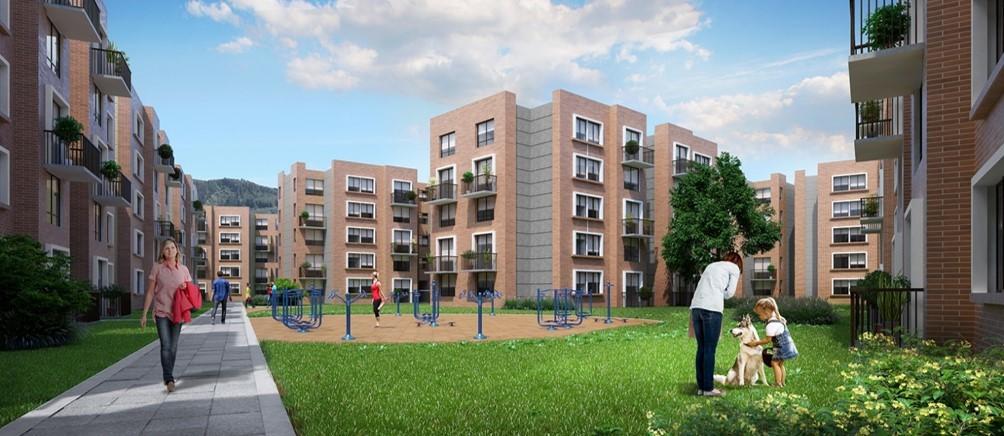Piamonte, HQE certified social housing operation in Colombia
6617
Last modified by the author on 31/10/2018 - 14:42

In the initial planning stages of Reserva de Madrid, a Low-Income Housing (LIH) Master Plan located in the outskirts of Bogota, Colombia, we in Prodesa came upon a big task. How to develop, on a very limited budget, the best possible green project (LIH in Colombia has to be priced under US$35,000 per unit, to gain government subsidies). As a founding member of the Colombia Green Building Council, Prodesa has been very active in applying green building principles since 2008. Our projects included many sustainable attributes. But do to the cost of some of the requirements and of the certification process, the projects were not certified. Colombia is one of the most biodiverse countries in the world, privileged by the richness of its ecosystems. We feel a special commitment to preserve this biodiversity by building sustainable projects.
Identity card of the project
The Company
Prodesa is a full-service Developer, established in 1991, with operations in several regions in Colombia and in South Florida, USA. During this 27 years we have developed 32,000 units, 80% of them Low-Income houses.
Piamonte
Located in the municipality of Madrid, one hour from Bogotá, Reserva de Madrid is an urban project developed in 25 hectares of land, with a total of 2,600 units distributed in nine housing residential complexes. The project was conceived for families with school-age children and young couples seeking their first home.
Piamonte is one of the nine complexes, and consists of 520 Low-Income apartments, in 26 five story buildings.
Sustainability Certification
One of the first steps was to select the certification seal, taking into consideration that we were developing a LIH project in a tropical zone and that we considered relevant that this process would be internationally recognized (at that time Colombia had no local green building certification in place). We evaluated Breaam, Leed Homes, Green Star and HQE, and selected HQE, due to its multi-criteria analysis, its applicability in LIH projects, its international recognition and the comprehensive approach to energy efficient, environmental friendly buildings and urban developments.
Certification Process
The next step was to get an early involvement of all of the key stakeholders, such as Prodesa’s management, Engineers, Architects, Suppliers, BIM specialists, etc. Many drafts were taken into consideration, each tested to make sure the budget was under control.
During this phase, an important element to expedite the process, and adapt HQE to Colombian regulatory and climatic context, was the support received from the HQE Consultant (Terao Colombia) and the important inputs by the independent auditor.
As a result of all of this collaboration, and when compare to our previous projects, Piamonte´s design achieved the following performance:
- 15% savings in electricity consumption (36 KW/m2) per year
- 15% savings in water consumption (85 l/day) per person
- efficient natural ventilation
- 54% of the 25 hectares are green areas
- autonomous solar lighting system in common areas
- low VOC and non-carcinogenic materials
- improved waste management
- better acoustic comfort in apartments and amenities
- faster sales
- an increase of 0.6% in direct cost, due to the certification process
Piamonte is the first certified housing project in Colombia and the first certified Low-Income Housing project in Latin America.
Lessons Learned
- Make sustainability and user well-being your top priority. Always take into consideration what is best for the user well-being in the long run.
- Involve High Management in the process. To make the hard decisions regarding the designs, materials to be used and specially the project proforma, it is important that the company´s directors are convinced of the benefits of having a green project.
- Involve all Key Stakeholders Early. It expedites the process and prevents having additional costs and delays due to reworks.
- Proof your Business Case (Costs vs. Benefits). It’s very nice to have a green project, but if it does not make an economic, this will not be sustainable in time.
Next Steps
The audit report for the construction phase included these notes:
- “the environmental profile has attained the Excellent level, making the project even more remarkable”
- “the landscape project goes far beyond the scheme’s requirement … focusing on life quality conditions for the inhabitants and users, while taking in account environmental aspects like water consumption and biodiversity enhancement.”
- “the worksite management was outstanding, … going beyond in several aspects, for instance waste recovery, which has reached 81% of the total waste…”
As a result of this certification process and the commitment of Prodesa to deliver to our buyers the best sustainable projects, in 2017, Prodesa signed an agreement with Cerway to certify 15 new projects, a total of 8,000 units.
Article signed Carlos Vargas, vice-president of strategic units, Prodesa, Colombia.
Read more :
- Prodesaenterprise https://prodesa.net/lenterprise/
- The project onbeHQE.com https://www.behqe.com/CONJUNTORESIDENCIALPiamonteReservadeMadri
- The Colombia Green Building Council http://www.worldgbc.org/member-directory/colombia-green-building-council
Share :



